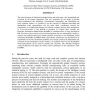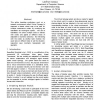682 search results - page 32 / 137 » Autonomous Environment and Task Adaptation for Robotic Agent... |
DAGSTUHL
1994
13 years 9 months ago
1994
The main advantage of distributed controlled robots and subsystems is the decentralized task execution by the system components. This way, properties for the design of flexible co...
ECAL
1999
Springer
13 years 12 months ago
1999
Springer
Abstract. This paper is concerned with arti cial evolution of neurocontrollers with adaptive synapses for autonomous mobile robots. The method consists of encoding on the genotype ...
ICAS
2006
IEEE
14 years 1 months ago
2006
IEEE
Abstract—This paper describes and evaluates a biologically-inspired network architecture that allows grid services to autonomously adapt to dynamic environment changes in the net...
IJCAI
2003
13 years 9 months ago
2003
This article describes preliminary work on a research environment called Virtual Synergy to represent a shared virtual map of an area for multiple autonomous robots by modifying t...
ICRA
2006
IEEE
14 years 1 months ago
2006
IEEE
— We introduce the concept of Ecology of Physically Embedded Intelligent Systems, or PEIS-Ecology. This is a network of heterogeneous robotic devices (PEIS) pervasively embedded ...


